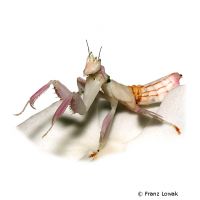Pink Orchid Mantis (Hymenopus coronatus)
| Pink Orchid Mantis Hymenopus coronatus | |
|---|---|
| Name | Pink Orchid Mantis |
| Name Lat. | Hymenopus coronatus |
| Family | Flower Mantids |
| Family lat. | Hymenopodidae |
| Order | Praying Mantids |
| Order lat. | Mantodea |
| Origin | South and Southeast Asia |
| Habitat | Rainforest |
| Diet | Flying insects |
| Humidity | 60-80 % |
| Behavior | Predatory |
| Keeping | Individual |
| Care Level | Moderate |
| Housing | Semi humid terrarium |
| Breeding | Moderately difficult |
| Life Span | 6-10 months |
| Protection | No |
| Metric Units | |
| Size | 4-7 cm |
| Temperature Day | 25-30 °C |
| Temperature Night | 22-24 °C |
| Housing Size | 20 x 20 x 30 cm |
| US Units | |
| Size | 1.6"-2.8" |
| Temperature Day | 77-86 °F |
| Temperature Night | 72-75 °F |
| Housing Size | 10" x 10" x 10" |
Distribution and habitat
The range of the orchid mantis extends from India through Thailand, Malaysia to Sumatra, Java and Borneo, where they live in the rainforests on leaves and flowers, preferably of orchids. They occur in many different color variations.
Maintenance
For a female an insectarium of 20 x 20 x 30 cm (L x W x H), for a group of up to 5 males 30 x 30 x 50 cm, can be recommended as a guideline, which should be placed in a quiet place without sunlight. A cover of gauze or fine metal mesh is recommended
You will need an insectarium structured with thin, strongly branched climbing branches (hiding places, privacy screens), dense planting with flowers (also artificial), and a small, shallow drinking vessel with water gel or a cotton trough. Artificial or live plants (e.g. orchids, Ficus pumila, Scindapsus aureus) are suitable for decoration. The substrate of coconut fibers, vermiculite or sand-clay-peat mixture (terrarium humus) should always be kept slightly moist. Daily, preferably in the evening, the inside of the terrarium should be finely sprayed with water (humidity), better is a rain or mist system. Waterlogging should be avoided at all costs.
| Temp. day: 25-30 °C | Temp. night: 22-24 °C | Humidity: 60-80 |
The lighting duration should be 12 hrs. Light sources that also produce the necessary heat are ideal.
Diet
They are predatory and seize the prey, preferably flying insects, with lightning speed from an angled lying-in-wait position with their tentacles. The food supply should consist of crickets, house crickets, various flies (e.g. Drosophila) and grasshoppers as well as small arachnids. It is important to regularly add minerals and vitamins (e.g. by dusting the feeders). The quality of the feeders can be enhanced by feeding overripe fruit and honey water
During molting, no predatory feeders (e.g. crickets) should remain in the insectarium, as during this time the animals are unprotected and can become prey themselves.
A varied diet promotes health and prevents deficiency symptoms.
Reproduction and breeding
Adult males are only about half the size and much more delicate than females. The base of the dorsal shield is brown in males and green in females
After mating, which lasts up to 10 hours, the female lays the first egg package (ootheca) after 2-3 weeks, up to 4 more can follow. At a temperature of 30 °C and a humidity of about 80 % about 40 dark red and black colored young, which resemble ants (mimicry), hatch after 4-6 weeks. They should be fed immediately with small fruit flies or microheims so that they do not eat each other (cannibalism).
After imaginal molting, females are ready to mate in about 2 weeks, males in about a week. After that the males live about 6 months, the females 10 months.
Important
Before mating, the female should be offered a large food animal to reduce the risk of her eating the male. It is recommended to keep females singly, males can be kept in a group (about 5 animals). They have very good camouflage due to their body shape and coloration as well as their often long-lasting motionlessness
For moulting they hang upside down in the branches or on the lattice cover and slide out of their old shell. Therefore they need at least one body length of free space below them.
Before purchasing, an insectarium should be prepared that meets the species-specific needs. Good ventilation without drafts is necessary, as well as equipment for measuring temperature and humidity. The lighting must correspond to the day-night rhythm appropriate for the species and must be installed in such a way that the animals cannot injure themselves. The insectarium should be locked in such a way that neither unauthorized persons can open it nor the animals can escape. Special attention must be paid to thorough hygiene and contamination must be removed regularly.
Further literature can be found in your pet store.
References
Text: Serena Werle; Image: Franz Lowak
Source: HENKEL & SCHMIDT (2010): Taschenatlas Wirbellose für das Terrarium, Verlag Ulmer; ENGELMAN & LANGE (2011): Zootierhaltung - Tiere in menschlicher Obhut: Wirbellose, Verlag Harri Deutsch
